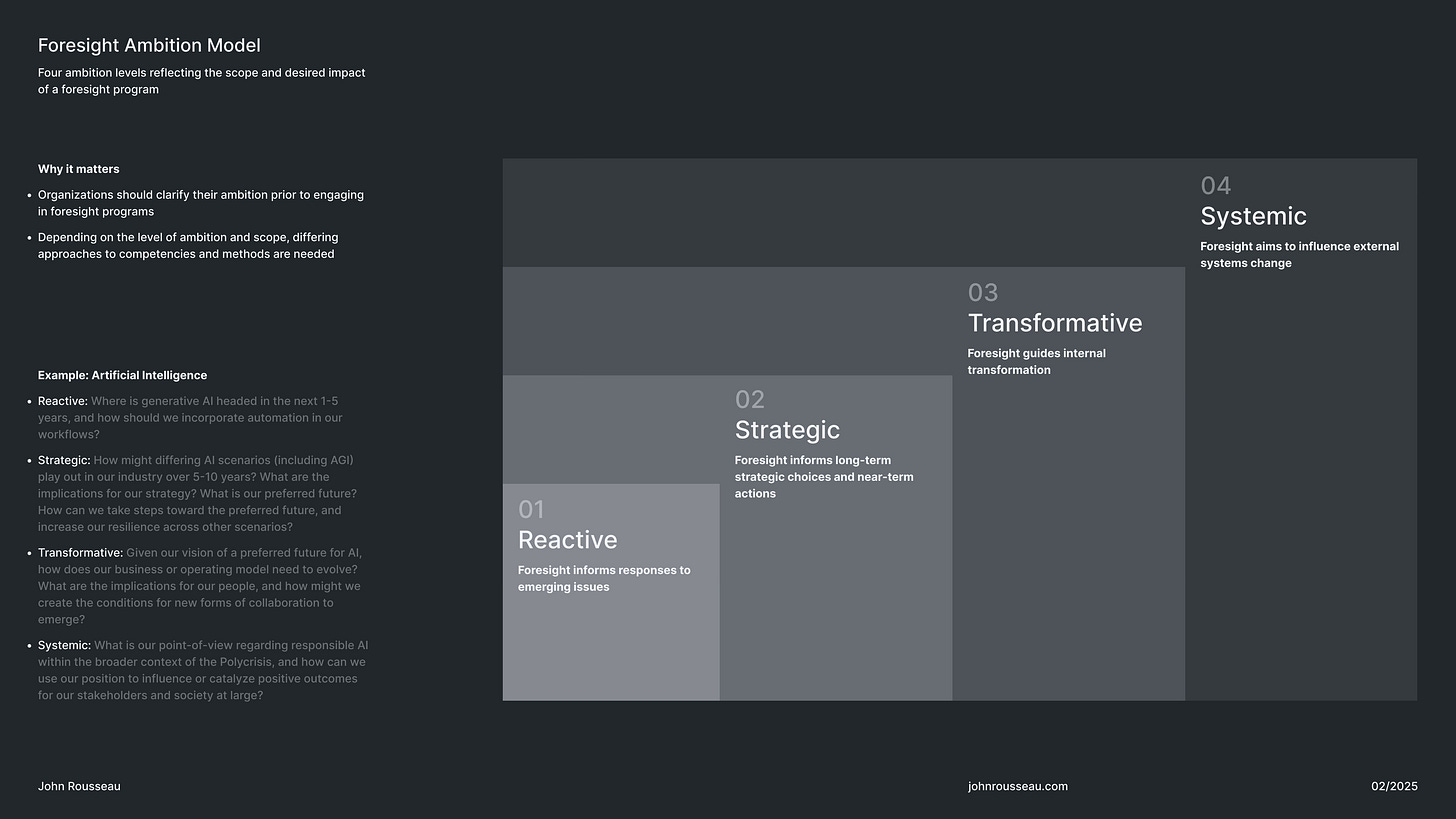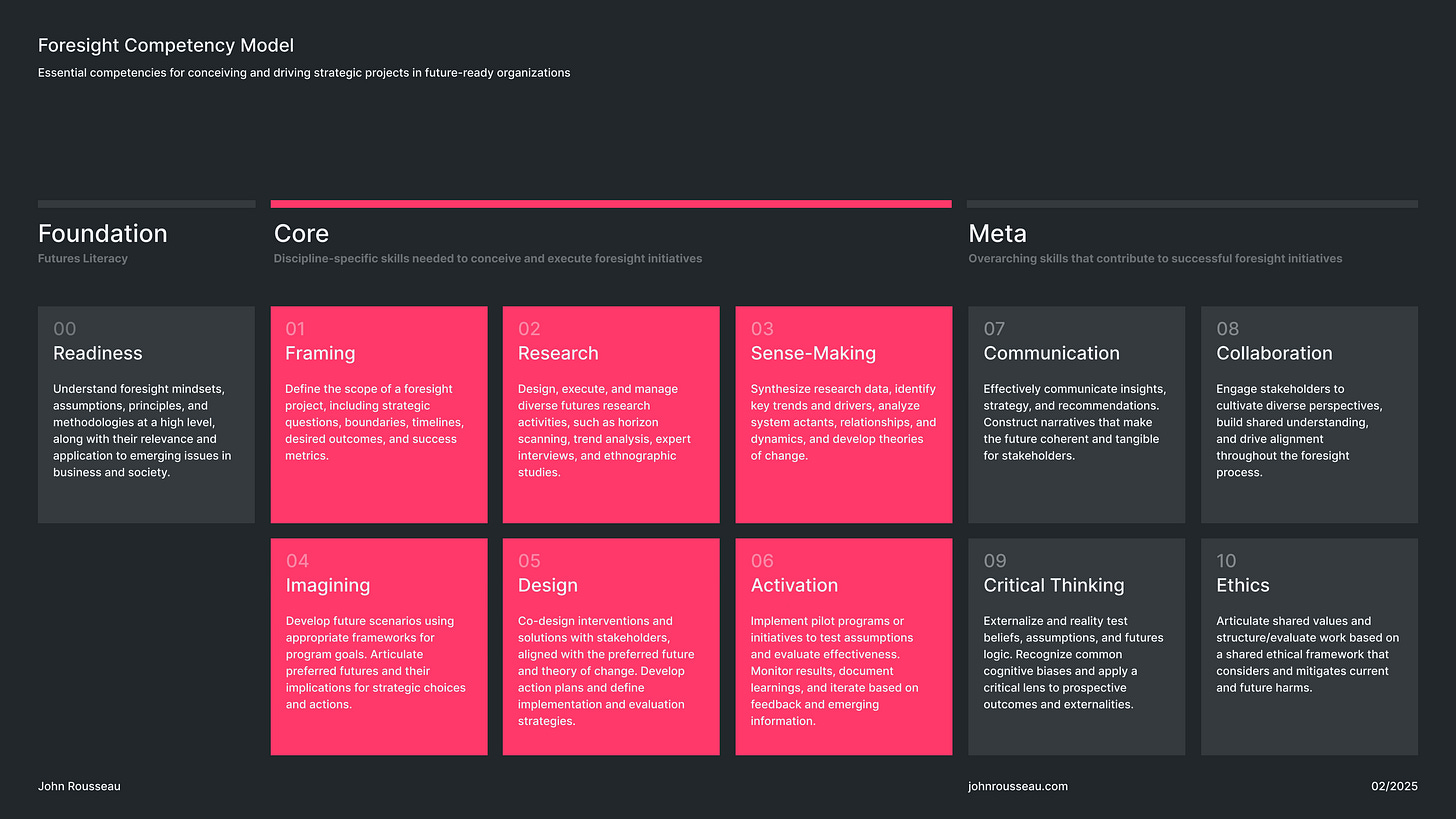Man proceeds in the fog. But when he looks back to judge people of the past, he sees no fog on their path. From his present, which was their faraway future, their path looks perfectly clear to him, good visibility all the way. Looking back, he sees the path, he sees the people proceeding, he sees their mistakes, but not the fog.
– Milan Kundera
The Need for Foresight
My intuition is that most organizations do not think about the future as often or as deeply as they should. Amidst widespread sentiment that long-term thinking is necessary and helpful, many leaders discount the future, preferring quantitative forecasts to speculative scenarios despite the fact that there are no future facts, only assumptions.
The utility of foresight is in revealing and structuring assumptions about reality and creating theories of change about prospective futures, which facilitates greater strategic clarity and thus better decisions and more purposeful actions in the present. Then, as new information emerges, organizations can adapt to change while maintaining strategic coherence. The benefits are greater long-term resilience and proactive imagination—the ability to create new futures rather than simply reacting to what happens next.
The alternative—business as usual—is increasingly unfit for purpose.
Reasons for this include:
The increasing rate of technological change
Interconnected global crises (“The Polycrisis/Metacrisis”)
Social, political, and economic turbulence
Epistemic confusion
Declining trust in institutions
Etc.
What these issues have in common is that they are the product of complex adaptive systems—indeed, a sprawling and entangled system of systems. Complex systems like societies, economies, and organizations contain independent actors with varying degrees of agency, can reorganize to achieve goals, display non-linear and ambiguous causality, and are in perpetual flux.
Dave Snowden’s Cynefin framework makes the following distinction between ordered, complex and chaotic systems—per the Cynefin Wiki:
At its most basic, the Cynefin® framework allows us to distinguish between three different kinds of systems:
Ordered systems in which cause and effect relationships are either clear or discoverable through analysis;
Complex systems in which the only way to understand the system is to interact;
Chaotic systems in which turbulence prevails and immediate stabilizing action is required.
Consider then, the degree to which many organizations operate by best practices. Because humans are uncomfortable with uncertainty, we seek prior examples and learn through retrospective coherence and narrative—tactics that help us understand ordered systems but are maladapted in complexity.
Creating New Futures
So, the primary object of foresight is anticipating emerging change and influencing preferable futures in complex systems.
This means that firms will need to develop greater systems awareness and internal foresight capacity, either via guided programs or dedicated resources and new capabilities. In either case, it is essential that the organization learns by doing. In my consulting work with large organizations, I notice a significant difference in programs where leaders are engaged in sense-making and generative imagination compared to those where they are consumers of information. In these programs, teams naturally develop a shared understanding and vernacular—a new way of thinking about and working with the future.
Consequently, my view is that foresight should be highly contextual (integrated within the organization and its operating environment) and collective (engaging a broad range of stakeholders in sense-making and co-creation).
In other words, you can’t simply commission a report. How many of those have you read? How many do you remember?
You have to do the work if you want to create new futures.
Still, it’s hard to know where to begin. The foresight field includes a wide range of perspectives on theory and practice, while learning options outside academia tend to focus on generic methods. Prior efforts to define organizational foresight maturity (Grim 2009, Rohrbeck 2011) and professional competencies (Hines, et al. 2017) provide a foundation for developing more accessible approaches that are adapted to the current environment.
Building on this thinking, I developed the following tools:
Foresight Ambition Model (FAM): a way to define the ambition of foresight programs relative to desired impact and context
Foresight Competency Model (FCM): a way to map foresight capabilities agnostic of specific methods, tailored for organizations
The Foresight Ambition Model (FAM)
Introducing the Foresight Ambition Model
What do you hope to achieve?
The FAM comprises four levels of ambition, reflecting the scope and desired impact of a foresight program. Higher levels include attributes of lower levels as scope broadens (e.g., a systemic level of ambition assumes that the organization is also using foresight to inform long-term strategy).
Reactive: Foresight informs responses to emerging issues
Strategic: Foresight informs long-term strategic choices and near-term actions
Transformative: Foresight guides internal transformation
Systemic: Foresight aims to influence external systems change
Example: Artificial Intelligence
Using AI as an example, differing levels of ambition might look like the example below. Note that given the pace of development and the high level of uncertainty, illustrative timelines are shorter than might be typical in other domains.
Reactive: Where is generative AI headed in the next 1-5 years, and how should we incorporate automation in our workflows?
Strategic: How might differing AI scenarios (including AGI) play out in our industry and beyond over 5-10 years? What are the implications for our strategy? What is our preferred future? How can we take steps toward the preferred future, and increase our resilience across other scenarios?
Transformative: Given our vision of a preferred future for AI, how does our business or operating model need to evolve? What are the implications for our people, and how might we create the conditions for new forms of collaboration to emerge?
Systemic: What is our point-of-view regarding responsible AI within the broader context of the Polycrisis, and how can we use our position to influence or catalyze positive outcomes for our stakeholders and society at large?
Why it matters
Organizations should clarify their ambition prior to engaging in foresight programs
Depending on the level of ambition and scope, differing approaches to competencies and methods are needed
Introducing the Foresight Competency Model
How will you achieve your goals?
The FCM builds on previous competency models (Hines, et al. 2017), with notable differences designed to increase relevance and applicability for organizations in the current environment:
Introduction of a "Foundation" layer to emphasize the importance of organizational futures literacy as a precondition of foresight readiness
Introduction of “Sense-Making” to emphasize the importance of synthesis, and to explicitly integrate complexity as a foundational ontology
Expansion of “Design” and the introduction of “Activation” to emphasize the importance of connecting foresight to action in the present, as part of an ongoing learning journey and to foster continuous iteration and innovation
Introduction of a “Meta” layer to emphasize the overarching skills that contribute to effective foresight—communication, collaboration, critical thinking, and ethics
The Foresight Competency Model (FCM)
Components of the FCM
The FCM is organized in three parts: Foundational Knowledge, Core Skills, and Meta Skills.
1. Foundational Knowledge
Futures Literacy
Readiness: Understand foresight mindsets, assumptions, principles, and methodologies at a high level, along with their relevance and application to emerging issues in business and society.
2. Core Skills
Discipline-specific skills needed to conceive and execute foresight initiatives
Framing: Define the scope of a foresight project, including strategic questions, boundaries, timelines, desired outcomes, and success metrics.
Research: Design, execute, and manage diverse futures research activities, such as horizon scanning, trend analysis, expert interviews, and ethnographic studies.
Sense-Making: Synthesize research data, identify key trends and drivers, analyze system actants, relationships, and dynamics, and develop theories of change.
Imagining: Develop future scenarios using appropriate frameworks for program goals. Articulate preferred futures and their implications for strategic choices and actions.
Design: Co-design interventions and solutions with stakeholders, aligned with the preferred future and theory of change. Develop action plans and define implementation and evaluation strategies.
Activation: Implement pilot programs or initiatives to test assumptions and evaluate effectiveness. Monitor results, document learnings, and iterate based on feedback and emerging information.
3. Meta Skills
Overarching skills that contribute to successful foresight initiatives
Communication: Effectively communicate insights, strategy, and recommendations. Construct narratives that make the future coherent and tangible for stakeholders.
Collaboration: Engage stakeholders to cultivate diverse perspectives, build shared understanding, and drive alignment throughout the foresight process.
Critical Thinking: Externalize and reality test beliefs, assumptions, and futures logic. Recognize common cognitive biases and apply a critical lens to prospective outcomes and externalities.
Ethics: Articulate shared values and structure/evaluate work based on a shared ethical framework that considers and mitigates current and future harms.
Why it matters
The FCM provides a roadmap for developing organizational foresight capacity, better tailored for operating in complexity
The model is both linear and episodic—linear in the sense that there is an ordered sequence of activities, and episodic in that the competencies are applicable as needed, can be recombined in new ways, and become increasingly integrated as the organization develops
The model is intended to adapt over time as conditions and context change
Closing Thoughts
The FAM and FCM are first steps toward a comprehensive model of organizational foresight adapted for complexity. I hope they provide a coherent structure on top of which methods may be better assembled and orchestrated to drive long-term strategy and near-term action. There is no one-size-fits-all.
By understanding their current level of foresight readiness in a complex environment, organizations can identify areas for improvement and tailor programs and learning to their unique goals. This will allow them to move beyond generic methods and develop practices that are appropriate to their specific context, empowering them to exercise greater agency in creating new futures.
Postscript
This is a work in progress. Ongoing work includes the production of a detailed guide to foresight methods mapped to the FCM/FAM and aligned to potential use cases.
If you enjoyed this post, please consider a one-time donation to support my independent design, writing, and research.
References
Cynefin.Io. (2023, April 16) https://cynefin.io/wiki/Cynefin#Misconception:_%22Cynefin_is_a_model%22
Grim, Terry. 2009. “Foresight Maturity Model (FMM): Achieving Best Practices in the Foresight Field.” Journal of Futures Studies 13 (4): 69-80.
Hines, A., Gary, J., Daheim, C., & Van Der Laan, L. (2017). Building Foresight Capacity: toward a foresight competency model. World Futures Review, 9(3), 123–141.
Rohrbeck, R. (2010). Corporate foresight: Towards a Maturity Model for the Future Orientation of a Firm. Springer Science & Business Media.




Thank you for sharing John. I greatly appreciate the visual quality and simplicity of your models /visuals. Inspiring. It's not often we experience such well designed, simple and clear visualizations.
I'm pretty novice to Foresight though, but one question has always been poking at me which I hope I could ask? What is the accountability of a Foresight program? I can see how it can show versions of the future, influence discussions, decision making and scenarios. But do you hold it accountable or evaluate it in some way?